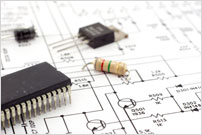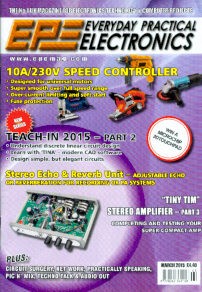March 2015 Issue
A summary of this month's contents.
10A/ 230V Intelligent Speed Controller for Universal Motors (Part 1)
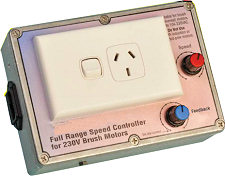
(Non-UK mains socket shown in the above prototype)
Motor speed control is one of the most popular applications of electronics requested by our readers. This very advanced microcontroller design will fit the bill perfectly, as it's ideal for use with power drills, strimmers, circular saws, machines, routers or any appliance having universal (brush-type) motors, and offers exceptionally smooth and precise speed control, great performance under load or at low speeds, soft-starting, RFI suppression and over-current limiting. It has a full 10A 230V rating.
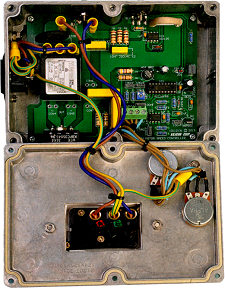 Not suitable for induction or shaded-pole synchronous motors (e.g. bench grinders or some tool sharpeners, record player motors, some garden tools and DIY equipment like some pressure washers) nor motors already incorporating basic electronic speed control (e.g. some power drills). Free source code suitable from the EPE Library. In Part 2 next month, constructional details are provided.
Not suitable for induction or shaded-pole synchronous motors (e.g. bench grinders or some tool sharpeners, record player motors, some garden tools and DIY equipment like some pressure washers) nor motors already incorporating basic electronic speed control (e.g. some power drills). Free source code suitable from the EPE Library. In Part 2 next month, constructional details are provided.
![]() This is an advanced design suitable for skilled and experienced constructors only.
This is an advanced design suitable for skilled and experienced constructors only.
Stereo Echo & Reverb Unit
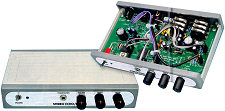
Based on the Stereo Audio Delay featured in the February 2015 issue, this modification to the original design offers adjustable echo or reverb for recording or PA use. Interval 0-640 ms.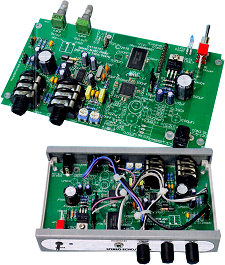
By using revised software (see this month’s source code file) together with slight changes to the circuitry, we explain how the same core hardware and p.c.b. can provide these different functions. We also explain some extra features that can be useful in either mode. A great project for audio enthusiasts!
“Tiny Tim” Stereo Amplifier (Part 3)
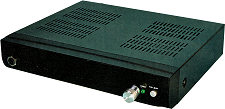
This month sees the completion of this high quality super-compact amplifier, with assembly, testing and setting up described in detail to enable you to construct this design with total confidence.
Teach-In 2015 Discrete Linear Circuit Design
Part 2: Testing and Measurements
Our tutorial series specially written for anyone wishing to develop a detailed understanding of linear discrete semiconductor devices. We use modern aids to simulate circuits on-screen, and analyse associated factors such as noise and distortion.
 This month we explain hybrid parameters and show you how they can be used to predict the performance of a transistor amplifier. Virtual test instruments are introduced, including the digital storage oscilloscope (DSO) and how to get started with the TINA Design Suite. Sound-card oscilloscopes for the PC are also included.
This month we explain hybrid parameters and show you how they can be used to predict the performance of a transistor amplifier. Virtual test instruments are introduced, including the digital storage oscilloscope (DSO) and how to get started with the TINA Design Suite. Sound-card oscilloscopes for the PC are also included.
There’s plenty of fact-filled information on offer, supported by plenty of screenshots and tutorial theory so if you want to know more about transistor circuitry then Teach-In 2015 is the series for you!
Also in this issue:
- Techno Talk – the future beckons, with 3D printing of electronic components. And could algae grown under LED lighting solve the world’s food shortages?
- Net Work – our in-house knowledge-worker introduces Wireshark and offers some practical tips to help budding authors publish their work on the Amazon Kindle platform.
- Practically Speaking – our hands-on, sleeves-up workshop column for hobby electronics enthusiasts
- Audio Out – the work of our audiophile columnist is subjected to some hypercritical analysis, and our designer answers right back!
- Circuit Surgery – the subject of constant current sources is expertly analysed by our highly-respected surgeon
- PIC n MIX – visiting a Hardware Hackathon in the Maker community!
- Max’s Cool Beans -- Max’s moving (coil) mini series continues with Max’s Super-duper Series Resistance Test Unit for checking out the workings of antique meters. Just the thing for steampunkers everywhere.
Next month: in April 2015’s issue, a Rubidium Frequency Standard, 10A/ 230V Intelligent Speed Controller for Universal Motors (Part 2), a USB-RS232C Interface and Teach-In Part 3 - Headphone Amplifier. Contents may be subject to change.
EPE is packed with practical electronics projects and theory for the hobbyist. You can order a printed copy of EPE for delivery to your door (worldwide), or try the PDF Version (needs Adobe Reader for Windows), or the Pocketmags for your mobile device. Subscribe now!
Source code and artwork files 0315.zip
![]() Revised 9/2/2015 : Teach-In update
Revised 9/2/2015 : Teach-In update
PCB artwork
As from July 2013 issue PCB artwork is available free to subscribers only.
Non-subscribers may purchase artwork files for a nominal sum. Please contact our Orders Dept for information or to place an order.
EPE Printed Circuit Boards
We can supply ready-made printed circuit boards (8-digit order codes) to the original design specification via mail order or from our Online Shop.

